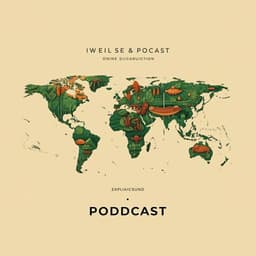
Biology
Effects of human disturbances on wildlife behaviour and consequences for predator-prey overlap in Southeast Asia
S. X. T. Lee, Z. Amir, et al.
Discover how anthropogenic disturbances in Southeast Asia are reshaping wildlife activity patterns, pushing rarer species into nocturnal habits while altering the behaviors of medium-sized and larger animals. This intriguing research by Samuel Xin Tham Lee, Zachary Amir, Jonathan H. Moore, Kaitlyn M. Gaynor, and Matthew Scott Luskin unveils the complexities of species interactions in disturbed habitats.
~3 min • Beginner • English
Introduction
A large majority of the Earth's land surface experiences anthropogenic disturbance, which alters wildlife community composition and animal behaviour, particularly diel activity. Animals may avoid humans due to contemporary and historical hunting pressure, reshaping the balance of foraging, predation risk, and competition that determines temporal niches. Human disturbances such as forest edges, logging, light pollution, presence of people, and hunting can shift wildlife activity patterns, potentially altering temporal overlap among predators and prey or among competitors, with implications for interactions and food-web dynamics. Prior work suggests many terrestrial species reduce daylight activity to avoid diurnal humans, but the consistency of shifts across species and whether changes favor crepuscular versus nocturnal periods remain unclear. The biological distinction matters because crepuscular periods provide intermediate light/thermal conditions while nocturnal periods offer darkness but potential thermoregulatory and foraging costs. Responses likely vary with species traits (body size, diet) and hunting pressure, with evidence that large hunted ungulates show stronger shifts than smaller species or predators. In this study across 10 Southeast Asian forest landscapes, the authors test hypotheses: H1) diurnal/crepuscular species in intact habitats shift toward nocturnality in disturbed habitats to avoid diurnal humans; H2) community- and guild-level changes are driven by winner–loser species turnover (e.g., diurnal specialists replaced by nocturnal/crepuscular generalists); H3) larger hunted species show stronger shifts; and H4) human disturbance increases temporal overlap of predator–prey and competitor pairs via repulsion from diurnal hours. Using the Forest Landscape Integrity Index (FLII) to differentiate intact versus disturbed forests, the study evaluates changes in activity distributions and temporal overlap to infer potential interaction changes in a region with high biodiversity and intensive disturbance and hunting pressure.
Literature Review
The paper synthesizes evidence that human disturbance commonly shifts wildlife toward nocturnality (e.g., Gaynor et al. 2018; Cox et al. 2022) and alters temporal niche partitioning and interactions (Carothers & Jaksić 1984; Kronfeld-Schor & Dayan 2003). It references the role of predators tracking prey activity using sensory cues and prey/competitors adjusting activity to minimize risks. Disturbance impacts vary across taxa and guilds, with large game species often exhibiting stronger avoidance of humans than smaller species or predators. Southeast Asia is highlighted as a system with severe deforestation, fragmentation, and hunting pressures, and previous work indicates increased spatial overlap and dominance by generalist species in disturbed landscapes, alongside historical extinction filtering that may yield contemporary communities more tolerant of disturbance. The study builds on methods to estimate diel overlap via kernel density approaches (Ridout & Linkie 2009) and addresses gaps in understanding whether shifts are crepuscular vs nocturnal and whether community-level interaction potentials change with disturbance.
Methodology
Study area and sampling: Camera traps were deployed across 10 tropical forest landscapes in Thailand (2), Peninsular Malaysia (2), Sumatra (3), Singapore (1), and Malaysian Borneo (2). A total of 1218 cameras were deployed over 20 sessions, yielding 58,608 trap nights and 31,138 independent detections. Cameras (Bushnell, Reconyx) were spaced >500 m in large forests (>50 km²) and 100–500 m in smaller patches, set ~0.3 m above ground on trails or paths, and run for 60–90 days per landscape. Independent detections were defined as conspecific images ≥30 minutes apart. Times were standardized for sunrise/sunset and seasonal variation using the overlap package, and detections were binned into day (07:30–16:30; 9 h), twilight (04:30–07:30 and 16:30–19:30; 6 h), and night (19:30–04:30; 9 h).
Disturbance proxy: The Forest Landscape Integrity Index (FLII; 0–10, higher = more intact) was extracted at camera locations to represent observed and inferred human pressures (e.g., human density, infrastructure, agriculture, forest loss, edges, fragmentation, connectivity). For kernel density comparisons, cameras were split by the median FLII (8.77) into intact (FLII > 8.77) vs disturbed (≤ 8.77). Sensitivity analyses used quartile splits (Q1 ≤ 5.61 very disturbed; Q3 ≥ 9.73 very intact).
Taxonomic scope and guilds: All vertebrates >1 kg were included for community/guild analyses: 57 mammals (excluding humans), 4 terrestrial birds, and 2 reptiles. For species-level kernel density analyses, species required ≥15 detections per diel category, yielding 14 mammals and 1 bird. For pairwise overlap analyses, both species needed ≥20 detections in both intact and disturbed forests, resulting in 23 species (6 carnivores, 10 herbivores, 7 omnivores). Body-size classes: small <4 kg (25 spp.), medium 4–20 kg (26 spp.), large >20 kg (12 spp.). Guild assignment used PanTHERIA (mammals), AVONET (birds), and literature (reptiles). Four abundant generalists—bearded pig (Sus barbatus), wild boar (S. scrofa), long-tailed macaque (Macaca fascicularis), pig-tailed macaque (M. nemestrina)—accounted for 39% of detections in intact and 68% in disturbed forests; analyses were run with and without these species (the remaining 59 termed “rarer specialists”).
Kernel density estimation (KDE): Circular kernel density functions (activity distributions) were fitted using the activity package with 10,000 bootstrap iterations to derive 95% CIs. Overlap (Δ) between distributions was computed with overlap package (Δ4 with smoothing = 1 for n > 75; Δ1 with smoothing = 0.8 for n ≤ 75). Significance between activity distributions in intact vs disturbed was assessed using compareCkern randomization tests. Activity peaks (AP) within diel categories were identified as the highest density times. Behavioural shifts were defined by (1) a change in peak among day/twilight/night and/or (2) p < 0.05 difference between distributions.
Multinomial logit mixed models (MNLMMs): To test effects of disturbance on the probability of detections by diel category, MNLMMs (mclogit in R) were fit at community, guild, and species levels with forest integrity as predictor. Twilight was the reference category. Community-level models also included body size (categorical), continuous body mass, and feeding guild, and interactions with forest integrity. Random effects: species and landscape (REML). AIC was used for model selection. To assess species turnover effects, models without species random effects were also fit (detections equally weighted regardless of species).
Temporal interactions: Predator–prey and competitor species pairs were defined based on overlapping ranges, feeding guild, and body-size rules (predators consume same or smaller size classes; apex predator competition allowed; herbivore and porcupine size exceptions allowed). Omnivores were not assigned as predators in pairwise matrices due to primarily non-vertebrate diets or prey <1 kg (excluded from study). Pairwise temporal overlap (Δ) was computed for intact and disturbed forests. Community-level differences were tested with paired t-tests across pairs (predation: 138 pairs; competition: 68 pairs), and guild-level comparisons with Mann–Whitney U-tests. All tests were two-sided without additional multiple-comparison adjustments. Analyses used R 4.2.0.
Key Findings
- Sampling and scope: 31,138 independent detections from 1218 cameras over 58,608 trap nights across 10 Southeast Asian landscapes; 63 vertebrate species (>1 kg).
- Community-level KDE results: Moving from intact to disturbed forests, communities showed +1.2% diurnal and +2.0% crepuscular detections with −3.2% nocturnal detections (p < 0.001). The primary activity peak shifted earlier toward dawn (APintact ≈ 07:58 h to APdisturbed ≈ 07:01 h), and dusk peaks became more pronounced.
- Species turnover and behaviour: Four generalists (pigs and macaques) increased from 39% of all detections in intact to 68% in disturbed forests. They also became more diurnal in disturbed forests (+6.4% diurnal detections; p < 0.001). Excluding these four, the remaining 59 “rarer specialists” were generally crepuscular in both forest types but showed +6.9% nocturnal detections in disturbed habitats (p < 0.001).
- Guild-level KDE patterns:
- Large carnivores (>20 kg) reduced early-morning activity and became more cathemeral; tigers showed +16.5% nocturnal and +5.4% crepuscular detections in disturbed forests (p = 0.016).
- Medium carnivores (4–20 kg) shifted toward diurnality (+25.8%; p < 0.001).
- Small carnivores remained largely nocturnal (p = 0.11, n.s.).
- Large and small herbivores remained predominantly crepuscular (p > 0.05 for large; small herbivores p < 0.001 but remained predominantly crepuscular); medium herbivores became more nocturnal (+13.1%; p < 0.001).
- Large and medium omnivores increased crepuscular activity (p < 0.001); small omnivores showed non-significant increases in diurnal (+6.1%) and crepuscular (+3.9%) detections (p = 0.25).
- Sensitivity analysis (quartiles of FLII): More extreme splits produced qualitatively similar but stronger changes (e.g., medium carnivores +51% diurnal in most disturbed vs +25.8% with median split).
- MNLMMs: For all species combined, the best model included a three-way interaction (disturbance × body size × feeding guild), and there was a significant net effect of disturbance increasing nocturnality. Separate models for rarer specialists vs pigs/macaques showed no significant net effect, but strong differences in magnitude: at maximum disturbance (FLII = 0), Pr(night) specialists = 0.41 (CI 0.39–0.43) vs pigs/macaques = 0.089 (CI 0.066–0.11); at maximum integrity (FLII = 10), Pr(night) specialists = 0.46 (CI 0.44–0.48) vs pigs/macaques = 0.072 (CI 0.052–0.092). Disturbance drove reduced diurnality for larger (often hunted) carnivores and omnivores, while medium-sized carnivores and omnivores became more diurnal. When species identity was ignored (no species random effects), overall nocturnality increases disappeared due to pronounced increases in medium omnivore diurnality and medium carnivore diurnality, indicating species replacements drive some guild-level trends.
- Temporal overlap of interactions: No significant difference in overlap (Δ) between intact and disturbed forests for competitor pairs (t68 = 0.22, p = 0.83) or predator–prey pairs (t1138 = 0.85, p = 0.40). No significant shifts by predator–prey or competitor size classes.
- Overall: Disturbance shifts community activity toward dawn/dusk, with opposing behavioural responses across guilds and sizes; species turnover (rise of generalist pigs and macaques and their predators) underpins community/guild patterns; potential temporal overlap for interactions is conserved.
Discussion
The study shows that human disturbance induces directional changes in wildlife diel behaviour in Southeast Asian forests through both behavioural shifts and species turnover. Rarer specialist species become more nocturnal in disturbed areas, supporting the idea that species avoid diurnal humans (H1), while larger, often hunted species reduce diurnality more strongly than smaller species (supporting H1 and H3). Concurrently, generalist pigs and macaques increase in both abundance (detections) and diurnality, driving community-level increases in diurnal/crepuscular activity (supporting H2 via winner–loser replacements). Despite these shifts, overall temporal overlap between predator–prey and competitor pairs did not change significantly with disturbance, failing to support H4 and suggesting that the potential for temporal interactions is conserved at the community scale. The nuanced, guild- and size-specific responses likely reflect differential hunting pressures, local contexts, and trade-offs with thermal and visual constraints. Examples include stronger diurnality reductions in bearded pigs in frequently hunted regions compared with wild boar in areas where hunting is limited by cultural taboos, and clouded leopard and leopard cat shifts tracking altered prey resources in disturbed habitats. The relatively modest magnitude of behavioural changes compared to some studies may reflect historical extinction filtering in Asia, producing communities more tolerant of disturbance, and constraints from physiological adaptations to light that favor crepuscular rather than fully nocturnal shifts. Linking temporal overlap changes to realized interactions will require integrating spatial overlap and dietary data across intact–disturbed gradients.
Conclusion
This study provides a multi-landscape, community-wide assessment of how human disturbance reshapes wildlife diel activity in Southeast Asia. It demonstrates a shift of community activity toward crepuscular periods in disturbed forests, driven by both behavioural changes (e.g., rarer specialists becoming more nocturnal; medium-sized generalists more diurnal) and pronounced species turnover (increased detections of pigs and macaques and their predators). Importantly, these behavioural and compositional changes do not translate into altered community-level temporal overlap among predator–prey or competitor pairs, suggesting potential interaction timing is conserved despite disturbance. Conservation implications include exploring temporal zoning of human activities (e.g., limiting noise/light during critical wildlife activity periods), aligning protected area access with key biological events (breeding, migration), and managing hyperabundant generalists (pigs and macaques) that may pose risks to agriculture and health. Future research should integrate spatial co-occurrence with diet analyses to connect behavioural shifts to realized interactions, and evaluate cascading effects of ongoing changes such as African swine fever impacts on wild pigs or potential macaque declines due to poaching for the medical trade.
Limitations
- Disturbance proxy and categorization: FLII is a composite index that may not fully capture site-specific disturbance histories or hunting pressure variability. Binary median splits can dampen contrasts between groups; quartile analyses reduce sample size.
- Statistical considerations: Multiple pairwise comparisons were conducted without adjustments, potentially inflating Type I error. KDE comparisons assess overall distribution differences but do not model nested designs or random effects; hence MNLMMs were also used.
- Sampling constraints: Camera traps capture terrestrial, camera-detectable activity of species >1 kg; smaller prey/predators and arboreal activity are underrepresented. Pairwise overlap analyses were limited to 23 species with adequate detections and required ≥20 detections in both forest categories.
- Inference limits: Temporal overlap reflects potential interaction likelihood, not realized interactions; spatial co-occurrence and diet were not directly measured in this study.
- Guild assumptions: Omnivores were not considered predators in overlap matrices due to diet composition and exclusion of <1 kg prey, which may omit some predatory interactions.
Related Publications
Explore these studies to deepen your understanding of the subject.







